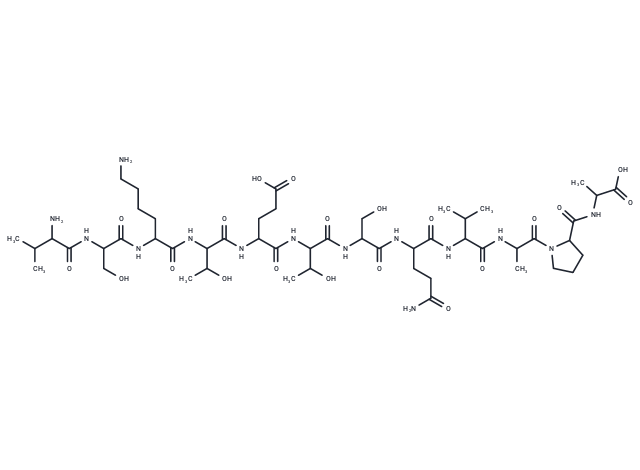Shopping Cart
Remove All Your shopping cart is currently empty
Your shopping cart is currently empty
Rhodopsin peptide is a peptide with the sequence H2N-Val-Ser-Lys-Thr-Glu-Thr-Ser-Gln-Val-Ala-Pro-Ala-OH, MW= 1217.33. Rhodopsin is a biological pigment in photoreceptor cells of the retina that is responsible for the first events in the perception of light. Rhodopsins belong to the G-protein-coupled receptor family and are extremely sensitive to light. Mutation of the rhodopsin gene is a major contributor to various retinopathies such as retinitis pigmentosa.

| Pack Size | Price | USA Warehouse | Global Warehouse | Quantity |
|---|---|---|---|---|
| 1 mg | $68 | Inquiry | Inquiry | |
| 5 mg | $198 | Inquiry | Inquiry | |
| 10 mg | $329 | Inquiry | Inquiry | |
| 25 mg | $459 | Inquiry | Inquiry |
| Description | Rhodopsin peptide is a peptide with the sequence H2N-Val-Ser-Lys-Thr-Glu-Thr-Ser-Gln-Val-Ala-Pro-Ala-OH, MW= 1217.33. Rhodopsin is a biological pigment in photoreceptor cells of the retina that is responsible for the first events in the perception of light. Rhodopsins belong to the G-protein-coupled receptor family and are extremely sensitive to light. Mutation of the rhodopsin gene is a major contributor to various retinopathies such as retinitis pigmentosa. |
| In vitro | In general, the disease-causing protein aggregates with ubiquitin in inclusion bodies disrupt the intermediate filament network and impairs the ability of the cell to degrade non-functioning proteins, which leads to photoreceptor apoptosis. Other mutations on rhodopsin lead to X-linked congenital stationary night blindness, mainly due to constitutive activation when the mutations occur around the chromophore binding pocket of rhodopsin. Several other pathological states relating to rhodopsin have been discovered including poor post-Golgi trafficking, dysregulated activation, rod outer segment instability, and arrestin binding [2][3]. |
| Molecular Weight | 1217.33 |
| Formula | C51H88N14O20 |
| Relative Density. | no data available |
| Sequence | H-DL-Val-DL-Ser-DL-Lys-DL-xiThr-DL-Glu-DL-xiThr-DL-Ser-DL-Gln-DL-Val-DL-Ala-DL-Pro-DL-Ala-OH |
| Sequence Short | VSKXEXSQVAPA |
| Storage | keep away from moisture | Powder: -20°C for 3 years | In solvent: -80°C for 1 year | Shipping with blue ice/Shipping at ambient temperature. |
| Solubility Information | DMSO: ≥121.7 mg/mL, Sonication is recommended. |
| Size | Quantity | Unit Price | Amount | Operation |
|---|

Copyright © 2015-2025 TargetMol Chemicals Inc. All Rights Reserved.